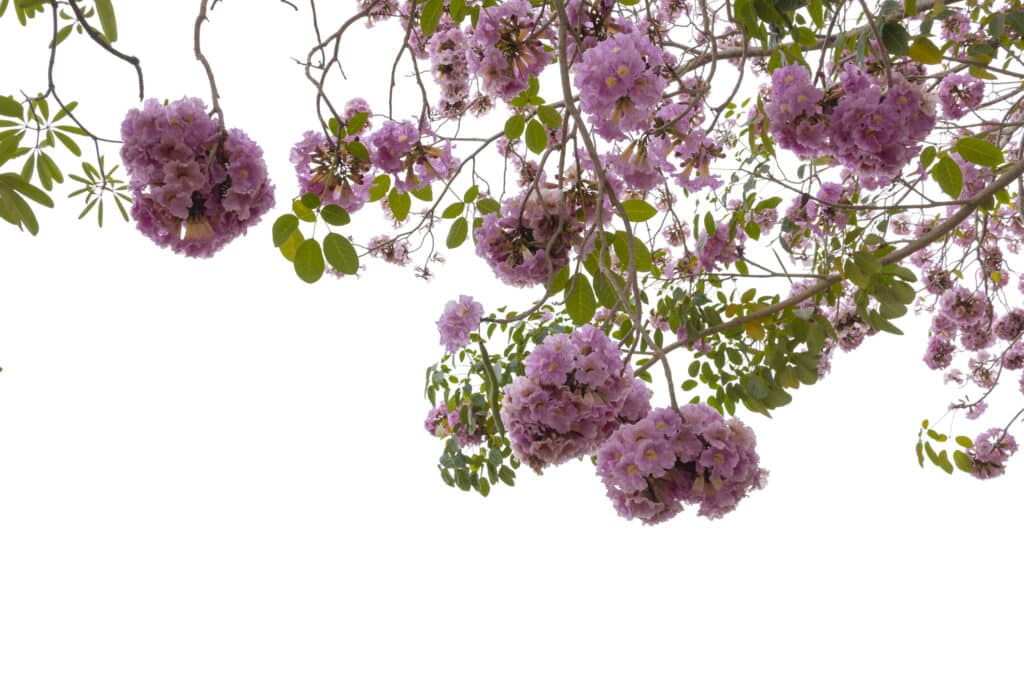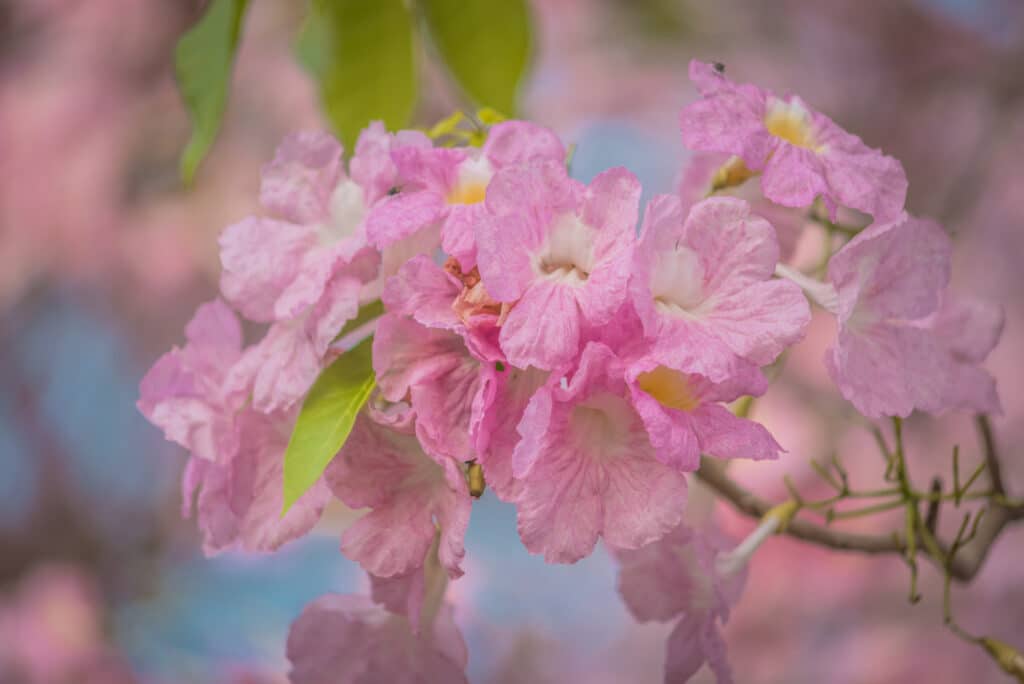Pink Tecoma (Tabebuia rosea), also called the Rosy Trumpet Tree, is admired for its vibrant, trumpet-shaped flowers and graceful canopy, making it a popular ornamental tree in Hawaii. Blooming during the dry season, it attracts pollinators like bees and hummingbirds, adding movement and color to gardens. Varieties such as Tabebuia rosea ‘Alba’ with white flowers and Tabebuia impetiginosa with purple blooms offer diverse visual appeal. Known for its adaptability, this tree thrives year-round in Hawaii’s climate, offering both shade and beauty with minimal maintenance.
Looking for a stunning, easy-to-grow tree that thrives in Hawaii? Pink Tecoma, scientifically known as Tabebuia rosea, might just be what you need. Also called the Rosy Trumpet Tree, this plant catches attention with its clusters of pink, trumpet-shaped flowers and graceful canopy.
Pink Tecoma has gained popularity across Hawaii, not only for its beauty but also for how well it adapts to the islands’ warm, tropical climate. Whether you’re looking to enhance your garden’s charm or add a decorative touch to landscapes, this versatile tree makes an ideal choice for local homeowners.
Pink Tecoma Details
The Pink Tecoma (Tabebuia rosea) stands out for its striking appearance. It can grow up to 25-30 feet tall, with a broad canopy that provides ample shade. The tree’s leaves are dark green and oval-shaped, adding lush greenery to any space year-round. However, it’s the flowers that make it so special.
During Hawaii’s dry season, the Pink Tecoma bursts into bloom, covering its branches with clusters of soft pink, trumpet-shaped flowers.
These blossoms are not just visually appealing—they also attract pollinators like bees and hummingbirds, adding life and movement to your garden. As the flowers fade, small, elongated seed pods may appear, adding texture to the tree’s appearance.

Varieties and Cultivars
There are several varieties and cultivars related to Pink Tecoma (Tabebuia rosea), each offering unique features in terms of flower color, size, and blooming patterns. Here are a few that thrive well in tropical climates like Hawaii:
- Tabebuia rosea ‘Alba’: This variety showcases white flowers instead of the typical pink, creating a stunning, elegant look for gardens and landscapes. It grows similarly in height and shape but adds a more subtle visual appeal.
- Tabebuia impetiginosa (Purple Trumpet Tree): Known for its lavender or purple blooms, this variety offers a deeper pop of color and can be a great choice for those wanting to mix and match flower colors in their garden.
- Tabebuia chrysotricha (Golden Trumpet Tree): Although not a pink variety, this bright yellow-blooming species from the Tabebuia family is quite popular. It thrives in Hawaii’s climate and can complement the Pink Tecoma beautifully in mixed plantings.
- Tabebuia heterophylla (Pink Poui): This variety has paler pink flowers with a hint of white in the center. It stays slightly smaller, making it ideal for more compact spaces.
These varieties give gardeners in Hawaii the flexibility to create dynamic landscapes with different colors and blooming styles, all while benefiting from the ease of maintenance that the Tabebuia species offers. Planting a mix of these varieties will keep your garden blooming and vibrant throughout the year.
Best Time to Plant
When it comes to planting Pink Tecoma in Hawaii, the climate offers a lot of flexibility. Because the islands enjoy tropical weather throughout the year, you can plant this tree almost anytime.
However, understanding Hawaii’s wet and dry seasons helps maximize your success. Proper timing ensures that the tree establishes strong roots, leading to faster growth and healthier blooms. With just a little planning, you can make sure your Pink Tecoma grows beautifully, no matter the season.
Year-Round Planting Feasibility
Year-round planting is feasible in Hawaii’s warm and stable climate. The key to successful planting lies in tailoring care based on the time of year. If you plant during the wet season (November to March), natural rainfall will significantly reduce the need for manual watering.
During the dry season (April to October), more frequent watering will be necessary to support early growth. Regardless of the time you choose, with regular care, the Pink Tecoma can thrive all year long.
Ideal Planting Seasons in Hawaii
Many local gardeners recommend planting Pink Tecoma at the start of the wet season for the best results. This timing ensures the young tree gets plenty of water to establish its roots without overburdening you with watering tasks.
As the tree builds a strong root system, it will be well-prepared to handle the drier months when water becomes scarcer. Planting at the right time will make a noticeable difference in how quickly your Pink Tecoma blooms. However, even during the dry season, a consistent watering schedule will guarantee healthy growth.
Growing Conditions
Growing Pink Tecoma (Tabebuia rosea) in Hawaii is quite manageable, especially if the right conditions are met. This tree thrives in tropical climates, making it an excellent fit for Hawaiian gardens.
Knowing the ideal soil type, sunlight, and moisture levels ensures the tree grows healthy and blooms abundantly. While the Pink Tecoma is quite hardy, providing it with the best conditions will result in vibrant flowers and robust growth. Let’s explore the essential growing requirements in more detail.
Ideal Soil Types and pH Levels
Pink Tecoma grows best in well-draining soil, such as sandy or loamy soil. It can tolerate poor soil conditions but performs exceptionally well when the soil is rich in organic matter.
Aim for a slightly acidic to neutral pH (around 6.0 to 7.5) to encourage the tree’s roots to absorb nutrients effectively. If the soil is heavy with clay, mixing in compost or sand improves drainage and prevents waterlogging. Healthy roots are crucial for this tree, so proper soil preparation will help it flourish.
Light Requirements
This sun-loving tree prefers full sunlight to grow and bloom to its fullest potential. It needs at least 6-8 hours of direct sunlight daily to produce vibrant flowers. While it can tolerate partial shade, too much shade may result in fewer flowers and slower growth.
Planting your Pink Tecoma in an open space with plenty of light exposure ensures lush foliage and striking blooms. Gardens, parks, or large backyards are perfect spots to plant this ornamental beauty.
Temperature and Humidity Preferences
Warm temperatures suit Pink Tecoma perfectly, aligning well with Hawaii’s tropical climate. It thrives in temperatures ranging between 65°F to 95°F and does well in the island’s natural humidity.
However, the tree also shows a decent tolerance to brief dry periods, especially once established. Frost and cold snaps can damage the plant, but such conditions are rarely an issue in Hawaii. With proper watering during the dry season, Pink Tecoma will stay healthy year-round.
Planting Instructions
Getting your Pink Tecoma (Tabebuia rosea) off to a great start requires thoughtful preparation and care. While this tree is known for being resilient, proper planting ensures healthy root development and maximizes its chances of thriving.
Whether you’re planting for shade or ornamental beauty, following these steps will help you set the foundation for long-term success. With the right approach, your tree will flourish and reward you with vibrant pink blooms in no time.
Step-by-Step Guide
- Choose the Right Location: Find a spot with full sun exposure, ensuring the tree gets 6-8 hours of sunlight daily. Make sure there’s enough room for the tree to grow up to 25-30 feet tall and spread wide.
- Prepare the Soil: Loosen the soil to a depth of 18-24 inches to encourage the roots to spread. If the soil is heavy, mix in organic matter like compost to improve drainage.
- Dig the Hole: Dig a hole about twice the size of the tree’s root ball. This gives the roots space to grow and reduces transplant shock.
- Place the Tree in the Hole: Position the tree carefully, ensuring the root flare (where the roots start to spread) is level with the ground. Avoid planting too deep, as this can suffocate the roots.
- Backfill and Water: Fill the hole with soil, lightly tamping it down to eliminate air pockets. Water thoroughly to help the soil settle and hydrate the roots.
Tips for Successful Establishment
- Water Regularly: Young trees need frequent watering, especially during the dry season. Aim to keep the soil consistently moist without overwatering.
- Use Mulch: Applying 2-3 inches of mulch around the base helps retain moisture and regulate soil temperature.
- Support if Needed: If your Pink Tecoma is in a windy area, consider using stakes to provide extra support during its early growth phase.
- Check for Pests: Regularly inspect the tree for signs of pests or diseases during the first few months to catch issues early.
- Fertilize Lightly: After a few months, use a balanced fertilizer to encourage healthy growth and flowering.
Following these steps ensures your Pink Tecoma establishes itself quickly and grows into a vibrant, healthy tree that will beautify your space for years to come.

Care and Maintenance
Once your Pink Tecoma (Tabebuia rosea) is planted and established, it requires regular care to thrive and bloom beautifully in Hawaii’s tropical climate. While this tree is known for being relatively low maintenance, providing consistent care ensures that it remains healthy, pest-free, and vibrant year after year.
Understanding its watering, fertilizing, and pruning needs will help you get the best results with minimal effort.
Watering Needs
Consistent watering is crucial, especially during the first few months after planting. During Hawaii’s dry season, make sure to water the tree deeply about two to three times per week, ensuring the soil stays moist but not waterlogged.
In the wet season, natural rainfall will reduce the need for frequent watering, but it’s still good to check the soil moisture regularly. Well-draining soil will prevent root rot from excess moisture.
Once established, Pink Tecoma becomes relatively drought-tolerant, but supplemental watering during prolonged dry spells helps maintain healthy blooms.
Fertilization Recommendations
For healthy growth and abundant flowering, fertilizing your Pink Tecoma can make a significant difference. Use a balanced fertilizer (like 10-10-10 or 12-12-12) every few months to ensure the tree receives essential nutrients.
Fertilize three times per year—once at the start of the wet season, once in the middle of it, and again before the dry season. This schedule promotes steady growth and ensures the tree is well-nourished year-round. Avoid over-fertilizing, as too much nitrogen can encourage foliage growth at the expense of flowers.
Pruning Guidelines
Pruning your Pink Tecoma is essential to maintain its shape and encourage flowering. Prune lightly after the blooming season to remove spent flowers and dead or damaged branches.
Occasional pruning also helps control the tree’s size, preventing it from growing too tall or wide for your space. Avoid aggressive pruning, as this can reduce the number of flowers in the next blooming cycle. Early pruning to shape the young tree helps it develop a balanced canopy and prevents branches from becoming tangled or weak.
Common Problems and Solutions
Even though Tabebuia rosea is generally resilient, it can still encounter a few challenges in Hawaii’s environment.
Knowing how to identify and address common issues will help keep your tree healthy and thriving. Proper monitoring and preventive care will go a long way in avoiding any serious problems.
Common Pests
- Aphids: Small insects that suck sap from the leaves, causing them to yellow and weaken. They also leave behind a sticky residue called honeydew, which encourages mold growth.
- Scale Insects: These pests attach to stems and leaves, feeding on sap and potentially stunting the tree’s growth.
- Spider Mites: Tiny pests that are difficult to spot but leave webbing on leaves. They thrive in dry conditions and cause discoloration or leaf drop.
Regularly inspect the leaves and branches to spot infestations early. Use a horticultural oil or insecticidal soap to treat affected areas and keep the pests under control.
Common Diseases
- Root Rot: Caused by overwatering or poor drainage, this disease leads to wilting and, if left untreated, can kill the tree.
- Powdery Mildew: A white, powder-like coating that forms on leaves, especially during humid conditions. This disease can reduce the plant’s health and affect flower production.
Ensure good air circulation around the tree to prevent mildew. Treat any signs of disease with organic fungicides, and improve soil drainage to avoid root rot.
Preventative Measures and Treatments
To prevent pests and diseases, keep the area around the tree clean and prune regularly to remove dead branches. Ensure the soil has good drainage to avoid waterlogging and apply mulch to retain moisture during the dry season without causing excess wetness.
During humid periods, monitor for signs of mildew and treat it early with a fungicide if needed. Natural predators, like ladybugs, can help control aphid populations. Regular maintenance ensures the tree remains healthy and free from serious problems.
Uses and Landscaping Tips
Pink Tecoma is a stunning choice for Hawaiian landscapes, offering both beauty and shade. Its wide canopy provides natural cooling, making it ideal for patios, garden seating, and walkways.
Many homeowners plant it as a focal point or along driveways, where its pink blooms enhance curb appeal. It pairs well with tropical plants like hibiscus, plumeria, or ornamental grasses, creating a vibrant, layered look. Beyond aesthetics, its flowers attract pollinators, making it a valuable addition to the local ecosystem.
Propagation Methods
Propagating Tabebuia rosea can be a rewarding way to grow new trees for your garden or share with fellow plant enthusiasts.
This tree can be propagated using both seeds and cuttings, each method having its benefits. Growing from seeds takes longer but allows for the natural development of strong root systems.
Cuttings, on the other hand, offer a quicker way to establish new plants, especially when taken from healthy parent trees. Whichever method you choose, with proper care, your propagated tree will thrive in Hawaii’s climate.
Environmental Impact and Benefits
Beyond its beauty, Tabebuia rosea contributes to the environment in several meaningful ways. However, like any plant species, it comes with both ecological benefits and a few potential challenges.
Understanding these aspects helps gardeners make informed decisions and maximize the tree’s positive impact on their landscapes and communities.
Ecological Benefits
This tree provides essential habitat and food for pollinators like bees, butterflies, and hummingbirds, contributing to biodiversity. Its flowers, which bloom during the dry season, offer nectar when other plants may not, helping sustain pollinators year-round.
The dense canopy also helps reduce soil erosion by stabilizing the ground with its roots, making it useful in areas prone to runoff.
As a shade provider, it lowers temperatures in urban spaces, reducing the heat island effect. Additionally, the tree improves air quality by absorbing carbon dioxide and filtering airborne pollutants.
Potential Drawbacks
Despite its advantages, there are a few things to consider when planting Tabebuia rosea. Its aggressive root system can disrupt nearby structures if planted too close to sidewalks, walls, or pipes.
The tree also sheds flowers and seed pods, which can require frequent cleanup to maintain a tidy space. While relatively pest-resistant, if not pruned properly, it may become susceptible to branch breakage during heavy winds.
In some cases, overplanting non-native species like Tabebuia could impact local ecosystems, reducing habitat diversity. However, with thoughtful placement and regular maintenance, these challenges can be managed effectively.
Conclusion
Tabebuia rosea is an excellent choice for Hawaiian landscapes, offering beauty, shade, and ecological value. Its vibrant pink flowers, easy maintenance, and adaptability to Hawaii’s climate make it a favorite among gardeners and homeowners.
With proper care, thoughtful placement, and regular pruning, this tree can thrive for years, providing visual appeal and environmental benefits.
While it requires occasional upkeep, such as cleaning up fallen flowers and monitoring roots, the rewards far outweigh the challenges. If you’re looking for a tree that combines beauty with function, this species is a perfect addition to your garden.


